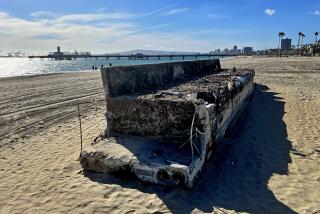Concrete Solution
- Share via
It hardly resembled a high-tech, multimillion-dollar marine mitigation project: piles of broken-up chunks of concrete being pushed off a barge into the ocean.
But Wednesday, when the last few pieces tumbled overboard with a splash, it marked the final stage in Southern California Edison’s unprecedented attempt to restore undersea habitat off the coast of San Clemente. The utility has been dumping rocks half a mile offshore for the past month, hoping to provide a new home for the kelp, crustaceans and other sea life damaged or destroyed by years of San Onofre nuclear plant operations.
“Ah, now that feels good,” said Samir Tanious, an Edison environmental affairs manager, as he watched the recycled concrete disappear underwater. “Our work here is done. Now it’s up to Mother Nature.”
Edison was ordered by the state Coastal Commission to help restore the sea habitat after a 15-year study showed in 1989 that the San Onofre facility’s cooling system was damaging a nearby kelp bed and sucking up and killing tons of fish and billions of eggs each year.
Controversy swirled around the study for years, with Edison officials arguing that the plant was less harmful to marine life than scientists had believed, and environmentalists accusing the company of trying to maximize profits while sacrificing environmental values.
Work finally began on the experimental reef last month, with crews spreading about 30,000 tons of quarry rock and concrete on the ocean floor between the San Clemente Pier and San Mateo Point.
The hope is that kelp spores floating in the seawater will begin growing on the rocks without human intervention, eventually forming the undulating kelp forests that are among the more spectacular ecosystems found in near-shore waters. That should rekindle more marine life offshore, in turn producing more productive fishing and diving.
Preliminary dives along the artificial reef have shown it to be working already, said Frank L. Melone, who manages the project for Edison.
“[Divers have] noticed a sheen of algae growing on many of the rocks, and lots of fish and lobsters swimming around in them,” Melone said. And once small plants begin to take root in the artificial reef, they can grow as much as 3 feet a day, he said.
“That’s the rewarding part about all this. . . . It doesn’t take long to see results.”
Colonization of the 22.4-acre reef will be monitored and studied for the next five years to see which material is more successful and where. Crews will then return to the ocean and expand the reef to the full 150 acres--expected to be the largest project of its kind in the nation--as required by the state order. Work on the first phase cost about $3 million, Melone said.
(BEGIN TEXT OF INFOBOX / INFOGRAPHIC)
Growing an Underwater Forest
Southern California Edison completed construction Wednesday of a 2 1/2-mile-long artificial reef off the coast of San Clemente designed to provide food, shelter and reproduction habitat for fish.
Adult Giant Kelp: Up to 50 feet
Spores shed, grow into kelp
Man-made reef: single layer of quarry rock, concrete chunks
Rocks should settle but not sink
Sand -- Up to 18 in.
Bedrock -- Up to 10 ft.
Sources: Southern California Edison; California Department of Fish and Game
More to Read
Sign up for Essential California
The most important California stories and recommendations in your inbox every morning.
You may occasionally receive promotional content from the Los Angeles Times.













